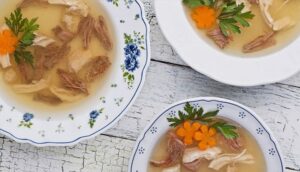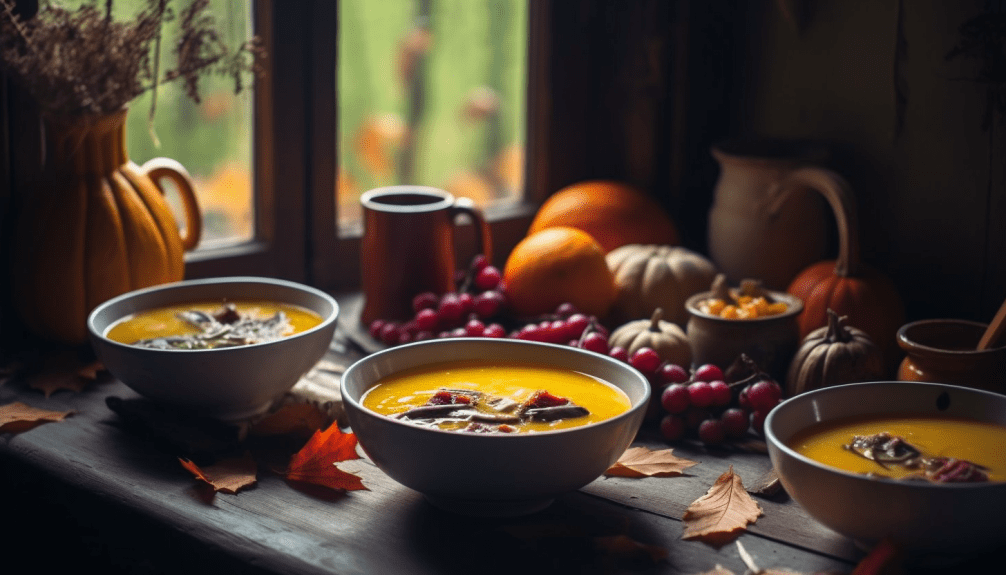Ukrainians have traditionally cooked many different dishes for the Easter celebration. While Easter bread and eggs play an essential ceremonial function, there are other recipes to include in your festive menu.
Festive meat and dairy dishes
Generally speaking, Easter dishes fall into two groups — meat and dairy. Dairy dishes may vary from region to region. Still, the most common are cottage cheese Easter cake, sweet casserole, pleskanka (baked cottage cheese), butter (sometimes shaped like a lamb using a unique metal mold), and cottage cheese pyrizhky (hand pies).
There is a fairly wide assortment of meat dishes: sausages, ham, cured bacon, kholodets (meat jelly), cabbage rolls, kruchenyky, and more modern dishes such as cutlets, chops, meat loaves, and even kebabs.
Holiday vegetable meals
Vegetable dishes were less typical on the holiday table, as Easter is usually celebrated in early spring. In the past, the stock of vegetables from the previous year ran out, and fresh veggies still needed to grow.
Nowadays, getting fresh vegetables in spring is relatively easy, so some people trying to cut their calories might opt for more salads for their Easter table. However, others still keep traditions going, and here are some authentic regional Easter meals.
Cheese paska
Sweet cottage cheese paska was and still is a popular Easter dish in Odesa, southern Ukraine, and Kyiv. To cook this paska, you need well-ground cottage cheese, cream/sour cream/dairy butter, eggs, and various exquisite add-ons such as almonds, raisins, and dried apricots for stuffing and decoration.
In the past, women mixed the components in a wooden mold (today, you can buy plastic molds of different sizes) and pressed it down with a weight. Then, paska was left for several hours to allow excess moisture to escape so the cake could hold its shape.
Cheese horses
The Hutsuls in the Carpathian Mountains created these unique edible toys, which some families still prepare for Easter. These figures are made manually using especially fermented sheep’s cheese. Their look depends on the master’s skills, and these figures are not something you can make right the first time you try.
Dip fragile wicker horses in a bowl with brine to shape them and make them more durable. This way, cheese horses will please your eye for quite a long time.
Roasted suckling pig
In the Slobozhanshchyna region (Northeastern Ukraine today), there was a custom of stuffing and baking a whole suckling pig. In the past, it was considered a symbol of earth, warmth, and fertility, signifying the homeowners’ wealth.
Traditionally people stuffed pigs with buckwheat or rice and decorated the snout. It was one of the main Easter menu dishes. Those families that didn’t have a piglet would bake a goose or a whole pike.
It is still a part of the holiday menu for some families, while other households prefer simpler recipes, such as bacon, pork, homemade sausage, or aspic.
Homemade horseradish, tsvikli or burachky
Grated horseradish is an indispensable add-on to many meat dishes. It can be served white or colored with beet juice or kvass.
In the western regions of Ukraine, people often make a dish called tsvikli containing grated horseradish and boiled beets seasoned with vinegar, salt, and pepper. It pairs perfectly with meat meals, as it has all four types of flavor: sweet, salty, sour, bitter, and savory.
Pleskanka
People in Lviv and Ivano-Frankivsk regions make pleskanka — a savory dish made from cottage cheese. This easy-to-prepare dish is a local Easter staple.
You start by squeezing the cottage cheese to remove moisture and then mix the cheese well with eggs, salt, and pepper. Additional spices vary from family to family and village to village, but paprika, cumin, cinnamon, cloves, and nutmeg are the most popular choices.
You can bake pleskanka in the dish you will use to serve your guests, saving you time and energy for other Easter recipes. Bake the dish at 170°C (340°F) for 30-40 minutes, until the top is well set, and serve cold.
Our blog has many interesting Easter recipes if you want to learn more. And you can always research recipes of specific Ukrainian regions. Each village had its interpretations and unique names for traditional Easter dishes. Some popular recipes of the past are forgotten, while others have come back as more and more Ukrainians research their family history to restore their lineage.










